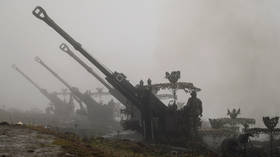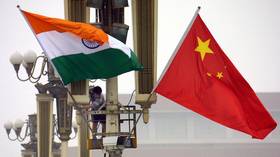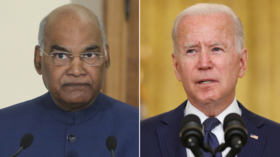India-China border impasse: What would be a common-sense solution?

Shortly after the latest border negotiations with India ended in a stalemate and amid growing worries over security, China on Saturday passed a new law on the protection and exploitation of its land border areas.
The law, which takes effect on January 1, 2022, “stipulates that the sovereignty and territorial integrity of the People's Republic of China are sacred and inviolable,” Xinhua reported. “The state shall take measures to safeguard territorial integrity and land boundaries and guard against and combat any act that undermines territorial sovereignty and land boundaries.”
Earlier this month, talks between Indian and Chinese military commanders to resolve the ongoing standoff on a stretch of disputed Himalayan border ended in a stalemate. It seems diplomats sitting in temperature-controlled offices are as clueless about what to do as the thousands of troops staring at each other high in the Himalayas.
As usual, both sides’ statements were almost exactly symmetrical; both accused the other of making unreasonable demands. The same symmetry exists about both nations’ versions of the deadly Galwan Valley clash in June 2020, which resulted in casualties on both sides – the first in 45 years. India says it’s all China’s fault; China says it’s all India’s fault. Neither side’s account can be independently verified of course; you believe who you want to believe.
All talk and no play
The first serious negotiations over the India-China border occurred in 1960, when the late Chinese premier Zhou Enlai visited India. Both countries at the time saw each other as not just representatives of two of the most ancient civilizations on Earth, but also as former colonial victims. The air was thick with anti-imperialist solidarity – both nations had just emerged as sovereign republics after centuries of suffering under imperialism. The slogan in vogue at the time in India was “Hindi Chini Bhai Bhai”, or “Indians and Chinese are brothers”.
But it was not to be. The two brothers fought a brief border war in 1962 (with a shorter series of clashes in 1967 and a standoff in 1987). The war coincided almost exactly with the Cuban missile crisis, and thus elicited little international attention. Bilateral ties remained frozen for years, until both countries re-established diplomatic relations in 1979.
Bureaucrats like talking. Almost as soon as diplomatic relations were re-established, mandarins from both sides got down to business. They rightly started negotiations on the border issue – but like most negotiations undertaken without political will, they achieved little. It was almost as if the chin-wagging was carried just as a performative PR exercise, or indeed, an exercise in garrulous diplomatic gloating. Diplomats love their clichés: they established “Working Groups”, “Political Parameters”, “Guiding Principles”, “Confidence Building Measures”, “General Frameworks”, “Special Representatives”, “Working Mechanisms” – the lot.
Until the ongoing standoff that started in 2020, the rap sheet included:
8 rounds of senior-level talks between 1981 and 1987
14 Joint working group meetings between 1988 and 2002
17 rounds of talks between special representatives since 2003
Activity became a substitute for achievement. After all, in the civil service, to quote from the British television show ‘Yes Minister’, success is measured by activity, not results.
Since 2020, the list (just to resolve the current standoff and negotiate troop withdrawals, not the whole border dispute), is even more impressive. In the 15 months ending in July 2021, more chins were wagged between India and China than almost any time in recent history:
12 rounds of corps commander level talks
10 rounds of major general level talks
55 rounds of brigadier level talks
1450 calls over hotlines
Even during the current impasse, each side has its favored clichés. India’s preferred platitude is that China has “unilaterally violated the status quo” – its standard narrative for every standoff with China, including the 2013 and 2017 border crises. China, meanwhile, keeps harping on about how India is “misjudging the situation”, and its favorite chestnut, how it “violated the consensus”.
Previous talks had led to some rudimentary successes. Many assumed that the negotiations were headed along the right path, when the 13th round of corps commander level talks occurred earlier this month.
It was a bloodbath. The negotiations broke down completely; with both sides accusing the other of being disagreeable. The same clichés were repeated, plus a tad extra, leading to the sharpest diplomatic exchange in months.
Also on rt.com Beijing urges Delhi to stop ‘doing things that undermine mutual trust & relations’ after Indian VP’s visit to disputed regionCrossing the line
Border incidents keep occurring because both sides disagree on where the border actually lies. Since both armies have differing perceptions of the boundary, army patrols keep crossing into territory the other side considers its own. Both armies do this, often one more than the other, but it is more frequently reported by the Indian media than the Chinese.
This is unlike India’s situation with Pakistan in Kashmir, where the temporary border, known as the Line of Control (LOC), is clearly defined, with both sides agreeing on where it lies. Thus, each army knows exactly until what point to patrol before turning back. That this luxury has not resulted in peace along the Indo-Pak border is a pity; and is a reflection of the intractable geopolitical situation in the region, not the soundness of demarcating a temporary border in the absence of a permanent one. Rather than patrols crossing each other’s paths, cross-border artillery shelling instead is more common across the LOC.
The common-sense solution, therefore, would be to demarcate a similar temporary border between India and China, while negotiations continue for a permanent boundary settlement. Such a line would define each army's farthest patrolling point – so that patrols don't run into each other, thus avoiding almost any possibility of a clash. There is such a temporary border, known as the LAC (Line of Actual Control), but believe it or not, both sides differ on where even this temporary border lies. Even arch-enemies like India and Pakistan can agree over their temporary border, but not India and China.
This is largely China’s fault. India has repeatedly asked for a proper, mutual demarcation of the LAC in border areas, but China has consistently refused. In 2015, Indian PM Narendra Modi himself raised the issue in a meeting with Chinese President Xi Jinping, elevating the agenda to the highest level of government. But China still wasn’t interested. Instead, it wants a “Code of Conduct” in the boundary regions, including a mutual freeze on border infrastructure development by both sides. This is shameless – China knows that it has far better infrastructure and more roads on its side (India having ignored developing its border regions for decades after the 1962 war). Now that India is catching up – both in terms of building of roads and frequency of patrols – China is grumbling. It has admitted that Indian infrastructure building and military deployment is the “root cause” of the current tensions. Now that China has saturated its side of the border with infrastructure for the People’s Liberation Army’s rapid deployment, it seeks to deny India the opportunity of doing the same on its own side.
Also on rt.com At least 5 Indian soldiers shot dead in Kashmir in deadliest violence since FebruaryNo give and all take
China wasn’t always this rigid. For decades, it was the more flexible party during negotiations. In 1960, Zhou Enlai presented a deal to Indian PM Jawaharlal Nehru that came to be known as the famous “package solution”: each nation would simply keep the territory it controls. China would recognize India’s claim in the eastern sector – provided India recognized China’s claims in the western sector. This would solve more than 95% of the dispute at a stroke; other minor areas (e.g. the central sector) could be negotiated separately. In other words, the current status-quo borders would largely be converted into the permanent international boundary.
This deal was heavily in India’s favor. It effectively meant that India would receive about three-quarters of the total disputed territory (the populated part), and would only need to give up its claims over the remaining quarter (the barren, unpopulated land of Aksai Chin). China would formally recognize India’s existing control over Arunachal Pradesh, while India would have to recognize China’s existing control over Aksai Chin.
However, since India is a “democracy”, its elected government often acts against its national interests. Nehru had raised nationalistic fervor to such an extent, that he found himself boxed in and unable to accept Zhou’s proposal. As he himself admitted, if he acquiesced to the deal, he would “no longer be Prime Minister of India”. This is common in democracies – elected leaders raise issues to a fever pitch, use them as tools to stoke nationalism, increase their popularity, and appease voters – only to find themselves handicapped on the negotiating table by their own over-exuberant rabble-rousing.
China doesn’t have this problem of course. Since its government is not directly “elected” to power, it can act in China’s national interest – without caring about votes. Chinese leader Deng Xiaoping again offered a similar deal to India in the 1980s on multiple occasions, but India again refused. Subsequently, sick of India’s repeated stubbornness, China stopped offering the package solution. In recent decades, China has brought forward new proposals, such as reiterating its claim over Tawang in Arunachal Pradesh, indicating that it would be willing to give up some other area in exchange for it.
India did not even reciprocate this flexibility, which led to a subsequent hardening of China’s stance over the next few decades. China has been willing to compromise and understands the principle of mutual give-and-take on both sides as a prerequisite to resolving disputed borders. India, on the other hand, considers all disputed territories as indisputably Indian, and thus non-negotiable. This negates the idea of any sort of territorial exchange. India simply lacks the political will to resolve its borders, whether with China or with Pakistan. This is a key feature of India’s democracy – it would be political suicide for any ruling party to agree to a border deal that would require re-drawing Indian maps. This has now become even more impossible after the deadly clashes last year.
With this stubbornness, and a final border settlement being inconceivable, the only thing left to do is to maintain peace along the disputed border – border management instead of border resolution. This is what both sides have largely been up to in the last few decades. Since the 1990s, a host of agreements have been signed, covering everything from artillery exercises to border patrols. This kept a fragile peace for 45 years, until the pressure cooker finally burst last year, with fatalities on both sides. Today, both nations accuse the other of violating these agreements.
Knowing each other’s boundaries
Neither side has covered itself in glory in the entire affair. India has no desire to resolve the dispute – since anything short of obtaining 100% of the total disputed territory (25% of which China controls) would be politically suicidal. India is not interested in permanent border resolution, only in temporary workarounds, such as demarcating the LAC. China, meanwhile, is not even interested in a workaround to keep the peace.
Yet, China’s earlier offer of formalizing the status quo remains the most common-sense solution. Both nations are nuclear powers; and it is unthinkable that either can acquire its claimed territory that the other side controls without fighting a full-fledged war, and perhaps not even then.
The most practical, permanent solution would be to settle along status-quo lines – with each side formally keeping what it controls. India has historically refused this, and China no longer offers it either. The second-best, temporary solution would be to mutually define and demarcate a LAC in all border regions to avoid border clashes, while negotiations continue. This, in turn, India has offered but China has refused. With each side talking past the other, and with tens of thousands of troops amassed at the border ready to fight, the day may not be far when the two nations again exchange more than just clichés.
Think your friends would be interested? Share this story!
The statements, views and opinions expressed in this column are solely those of the author and do not necessarily represent those of RT.
















